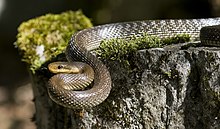This article needs additional citations for verification. (April 2014) |
| Rat snake | |
|---|---|

| |
| Aesculapian snake (Zamenis longissimus) | |
| Scientific classification | |
| Domain: | Eukaryota |
| Kingdom: | Animalia |
| Phylum: | Chordata |
| Class: | Reptilia |
| Order: | Squamata |
| Suborder: | Serpentes |
| Family: | Colubridae |
| Subfamily: | Colubrinae |
| Genera | |
|
See text | |
Rat snakes are members – along with kingsnakes, milk snakes, vine snakes and indigo snakes – of the subfamily Colubrinae of the family Colubridae. They are medium to large constrictors and are found throughout much of the Northern Hemisphere. They feed primarily on rodents. Many species make attractive and docile pets and one, the corn snake, is one of the most popular reptile pets in the world. Like all snakes, they can be defensive when approached too closely, handled, or restrained. However, rat snake bites are not dangerous to humans. Like nearly all colubrids, rat snakes pose no threat to humans. Rat snakes were long believed to be completely nonvenomous, but recent studies have shown that some Old World species do possess small amounts of venom, though the amount is negligible relative to humans.[1]
Previously, most rat snakes were assigned to the genus Elaphe, but many have been since renamed following mitochondrial DNA analysis performed in 2002. For the purpose of this article, names will be harmonized with the TIGR Database.
- ^ Fry, Bryan G.; Lumsden, Natalie G.; Wüster, Wolfgang; Wickramaratna, Janith C.; Hodgson, Wayne C.; Kini, R. Manjunatha (1 October 2003). "Isolation of a neurotoxin (alpha-colubritoxin) from a nonvenomous colubrid: evidence for early origin of venom in snakes". Journal of Molecular Evolution. 57 (4): 446–452. doi:10.1007/s00239-003-2497-3. ISSN 0022-2844. PMID 14708577. S2CID 21055188.